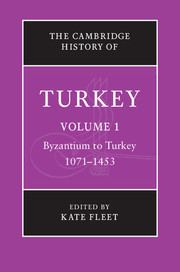Book contents
- Frontmatter
- 1 Introduction
- 2 The Byzantine Empire from the eleventh to the fifteenth century
- 3 Anatolia under the Mongols
- 4 Anatolia, 1300–1451
- 5 The incorporation of the Balkans into the Ottoman Empire, 1353–1453
- 6 Ottoman warfare, 1300–1453
- 7 The Turkish economy, 1071–1453
- 8 Art and architecture, 1300–1453
- 9 Social, cultural and intellectual life, 1071–1453
- Glossary
- Bibliography
- Index
- References
6 - Ottoman warfare, 1300–1453
Published online by Cambridge University Press: 28 March 2010
- Frontmatter
- 1 Introduction
- 2 The Byzantine Empire from the eleventh to the fifteenth century
- 3 Anatolia under the Mongols
- 4 Anatolia, 1300–1451
- 5 The incorporation of the Balkans into the Ottoman Empire, 1353–1453
- 6 Ottoman warfare, 1300–1453
- 7 The Turkish economy, 1071–1453
- 8 Art and architecture, 1300–1453
- 9 Social, cultural and intellectual life, 1071–1453
- Glossary
- Bibliography
- Index
- References
Summary
The formative period, c.1300–1370s
The early Ottoman military organisation was a peculiar a malgam of Turkoman nomadic, Seljuk-Ilkhanid and Byzantine elements, but it was the nomadic tradition which predominated among the various constituent parts in the early period of the formation of the state. As in other Eurasian nomadic societies, it may well have been very difficult to distinguish between society and military among the Turkomans living in the Bithynian marches. All followers of the Ottomans capable of fighting could and did participate in raiding or in defence if need arose. The predatory raids were called akin in Turkish, and those taking part in them were akinci (later, as the Islamic character of the state strengthened, the term gazi, that is, warrior of the faith, came to be preferred). Yet, apart from the undifferentiated bands of warriors, we see from the outset a relatively small but well-organised and well-trained force which gathered around the ruler and rendered services to him in war and peace.
This type of ‘military retinue’ was not an Ottoman invention. It was a universal institution which had existed in the east and the west since time immemorial. In the empires of the Inner Asian Turks and Uighurs the retinue of the kagan (ruler) was called buyruk, while the Karahanids and the Mongols knew it under the names koldaş and nökör, respectively.
- Type
- Chapter
- Information
- The Cambridge History of Turkey , pp. 192 - 226Publisher: Cambridge University PressPrint publication year: 2009
References
- 6
- Cited by

